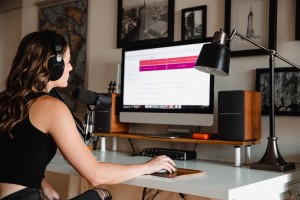The question comes up often: “Should I edit out my breaths in my voice-over work?”
Again, the standard answer for almost all things voice-over applies: it depends.
And again, Rule Number One is, “If the client says do, do. If the client says don’t, don’t.”
But what if the client doesn’t say? Or if it’s for an agent and not a client? Does that change from genre to genre?
Assuming there’s no specific direction on breaths from the person you’re working with (client, agent, etc.), there are some general guidelines for editing breaths in your voice-over work. They are not hard and fast rules and can change from client to client, casting agent to casting agent – hence, Rule Number One.

Commercial Work and Auditions
For commercial work, most casting and talent agents I’ve heard speak on the topic prefer that breaths be edited out. Some prefer that you leave them in. My approach is to edit out breaths in commercial work unless I know that person prefers to have them left in or I’ve been instructed to leave them in.
If you’re going to edit out your breaths, you must take care to preserve natural pauses where the breaths were originally. This often can be done best by replacing the breath with the same duration of room tone. After listening back to the edit, you may want to adjust the pause to keep it feeling as natural as possible.
If you’re going to leave the breaths in, then give the recording a listen to make sure that the breaths aren’t distracting from the performance. If some breaths seem particularly loud and have no dramatic or comedic reason to be, then you may want to reduce their volume. You may also want to clean up any mouth noise that accompanies the breath so that the breath is more or less pure.
Narration Work and Auditions
Narrative pieces are generally quite a bit longer than commercial spots. Typically, you would not edit out breaths in a narration. This is true for corporate, medical and technical narration, e-learning, and corporate training, but also especially true for audiobooks, as breaths can often be part of the performance. Besides, you don’t want to edit the breaths out of a 13-hour audiobook. Again, if a particular breath is distracting or loud (for no good performance reason), reduce its volume. This kind of breath should be occasional at worst.
A Word About Technique
The best fix for breathing issues is to make sure your breathing technique is solid. If you’re breathing properly in the first place, you’ll significantly reduce the amount of breath editing you have to do. Make sure you take the following steps to help insure proper breathing technique:
Script Markup
Properly prepare and mark up your script to make sure you know where your breaths will be. – Plan them spaced out in a way that you don’t run out of air and that they’re in appropriate places in the copy. – This is the first step in breath control. However, marking breaths, especially in long form, is not necessary, but can be helpful, especially when starting out as a voice actor/narrator, or generally in more difficult passages.
Keeping Aerobically Fit
The more aerobically fit you are, the easier you will breathe, and the more control you will have over your breath. Even brisk walking 20 minutes a day can help with breath control in your work.
Reducing the Loudness
If you’re a particularly loud breather, work on reducing the volume. Taking shorter, more frequent breaths can help. Inhaling through your mouth and not your nose is key. Relaxing the throat allows the air to glide into your lungs more quietly.
Mic Proximity
If you work closer to the mic, inside roughly 4-5 inches, experiment with backing off an inch or two to reduce the loudness of your breaths.
Left in or left out, breathing should never be a distraction to the performance. Breaths can also be a great artistic tool when used properly in a performance.
I wish you easy breathing and lots of bookings!
Check out our free PDF with pro-tips from real working voice-over actors here!
Want to learn more about voiceover? Signup for our introductory VO webinar.





